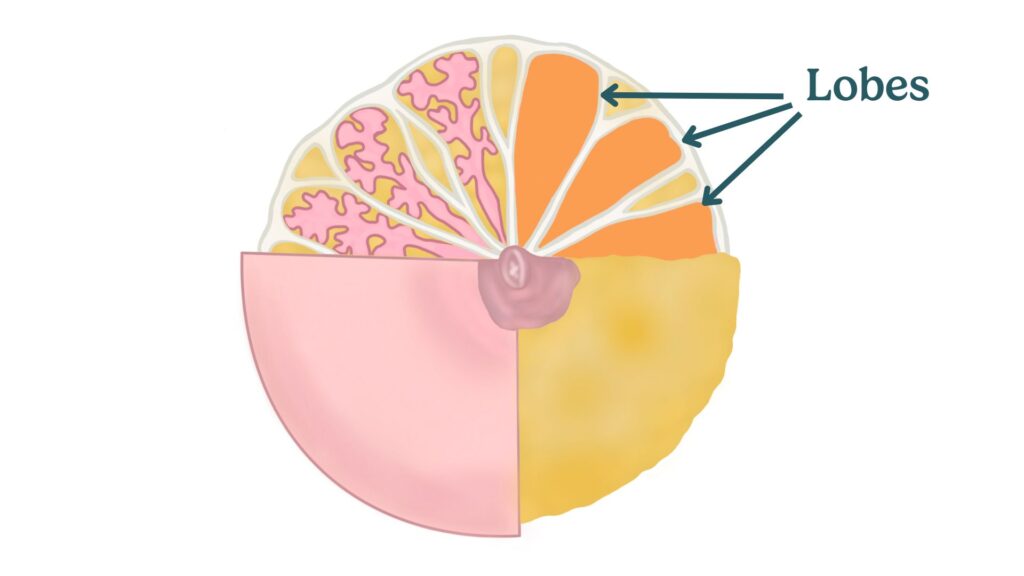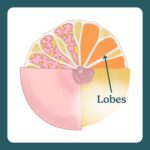lobes

What are lobes?
Lobes are sections within the breast that contain clusters of alveoli, the small grape-like sacs that produce milk. Each breast has about 15-20 lobes, and within each lobe, there are many smaller lobules connected to ducts. These ducts carry milk from the alveoli to the nipple, allowing your baby to feed.
When your baby latches on and suckles, it stimulates the release of the hormone oxytocin, which causes the muscles around the alveoli to contract and push milk through the ducts and out the nipple.
What to watch out for
Issues with the lobes can affect milk production and flow, leading to various breastfeeding challenges.
Here are some things to be aware of:
- Engorgement: When your breasts become overly full of milk, they can feel hard and painful. This happens when the lobes produce more milk than your baby consumes. Frequent nursing and ensuring a proper latch can help. Engorgement usually resolves within a few days to a week. If it lasts longer or makes latching difficult, seek help from a lactation consultant. Read more about engorgement
- Blocked ducts: These occur when inflammation surrounds the ducts and milk gets trapped in the narrowing ducts, causing a painful lump. This can prevent milk from flowing properly from the lobes. Continuing to nurse or pump, massaging the affected area, and applying cold compresses can help clear the blockage. Blocked ducts typically clear within 24-48 hours. If they don’t, or if signs of infection appear, seek medical advice. Learn how to manage plugged ducts
- Mastitis: This is an infection that causes breast pain, swelling, redness, and flu-like symptoms. It can reduce milk production in the affected lobes. Continuing to breastfeed and getting medical treatment promptly, sometimes with antibiotics, is essential. Early treatment can prevent complications and promote quicker recovery. Read up on mastitis
- Low milk supply: If the lobes aren’t producing enough milk, it can lead to insufficient nutrition for your baby. Frequent breastfeeding, ensuring a good latch, and consulting with a lactation expert can help boost milk production. If concerns persist after a week or two, or if your baby shows signs of dehydration, seek professional help. Check signs of low breastmilk supply
Physical limitations or health circumstances
Certain conditions can affect the normal function of the lobes and complicate breastfeeding:
- Insufficient glandular tissue (IGT): This condition means there is not enough milk-producing tissue, which can lead to a low milk supply. Working with a lactation consultant can help manage this challenge.
- Breast surgery: Previous surgeries, like reductions or augmentations, can impact the milk ducts and lobes. The extent depends on the type of surgery and techniques used.
- Hormonal imbalances: Conditions like PCOS or thyroid disorders can affect milk production. Proper management of these conditions is crucial for successful breastfeeding.
- Diabetes: This can delay milk production or reduce supply. Monitoring and managing diabetes can support better breastfeeding outcomes.
- Previous radiation therapy: Radiation to the chest can damage breast tissue, including the lobes, affecting milk production.
- Infections: Infections like mastitis can temporarily decrease milk production and cause significant discomfort.
Other terms
Here are some related terms you might find useful to understand:
- Alveoli: Small sacs in the lobes that produce milk.
- Milk ducts: Tubes that transport milk from the alveoli through the lobes to the nipple.
- Prolactin: The hormone that stimulates milk production in the alveoli.
- Oxytocin: The hormone that triggers the let-down reflex, pushing milk from the lobes to the nipple.
- Let-down reflex: The process by which milk is released from the alveoli through the ducts to the nipple.
- Engorgement: When the breasts become overly full of milk, causing discomfort.
- Blocked ducts: When milk is trapped in the ducts, causing lumps and pain.
- Mastitis: An infection in the breast causing pain, swelling, and flu-like symptoms.


